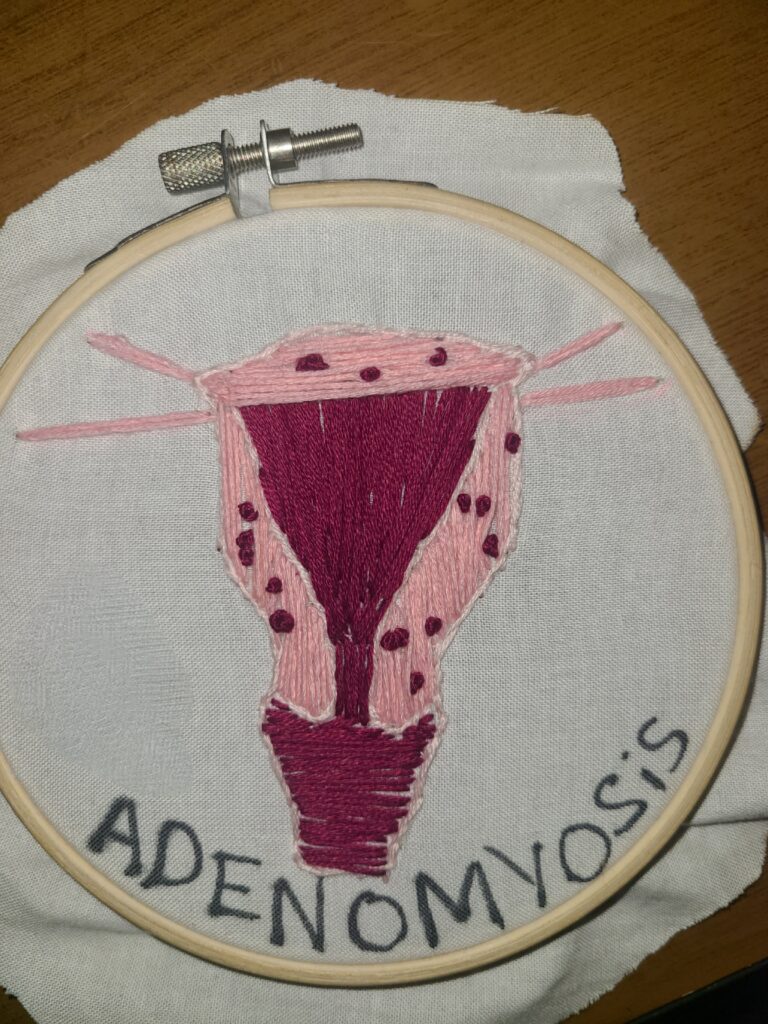For my STEAM project I wanted to dive more into the female reproductive system since I hope to become a midwife. As I researched different diseases that involve the uterus, I noticed a lot of information was focused on endometrioses. However, I noticed an article that mentioned adenomyosis. Adenomyosis is a condition that causes endometrial tissue (the tissue that lines the inside of the uterus) grows into the myometrium (middle muscular layer of the uterine wall) (Ameer, 2022)). The myometrium is what causes cramp or contractions of the uterus and is made up of smooth muscle cells (Hidaya Aliouche, 2022). The endometrium is the inner lining of the uterus that sheds during menstruation and is made up of luminal and glandular epithelial cells and the supporting mesenchymal cells (Sasson & Taylor, 2008). The endometrial tissue continues to act normal including shedding during menstruation even when it is grown into the myometrium this causes the uterus to become enlarged in some cases two to three times larger than its original size and often cause painful heavy periods. There are two types of adenomyosis depending on the dispersion of the endometrium. Diffuse adenomyosis is defined by the presence of multiple foci in the myometrium while focal adenomyosis are isolated nodules endometrium throughout the myometrium that have a measurable circumference (Moawad et al., 2023). The cause of adenomyosis is still unknown, however some treatments have been effective in lessening symptoms including hormone therapy and surgery such as endometrial ablation and hysterectomies which as of now are the only cure. Adenomyosis typically affects people with uteruses who are around the ages of thirty to fifty years old and commonly symptoms subside after menopause leading many people to wait until after menopause before trying surgical solutions however approximately two to five percent of adolescents with severely painful cycles have adenomyosis. But, one in three people who have been diagnosed with adenomyosis never have symptoms at all (Yale Medicine, 2022). Adenomyosis is typically diagnosed using a pelvic exam, ultrasound, sonohysterography, MRI, and endometrial biopsy (WebMd, 2024).
For the art part of STEAM I chose to embroider a uterus without adenomyosis and then add to that uterus the endometrium growing into the muscle wall. I chose embroidery because most people who have a uterus identify as female and embroidery has been a symbol of femininity since the early nineteenth century (Henry, 2021). Along with that symbolism it was my Grandma who taught me to embroider and she had endometriosis which is very similar to adenomyosis where the endometrium grows on the outside of the uterus. The embroidery shows from bottom to top the vagina, cervix, body, and fundus. The inside of the uterus and the endometrium are in magenta while the myometrium, part of the fallopian tubes, and part of the ovarian ligaments are in bright pink. The first image is of a uterus that does not have the endometrium in the myometrium. While the second image is of a uterus with focal adenomyosis indicated by the endometrium growing in the myometrium.
Ameer, M. A. (2022, December 6). Anatomy, abdomen and pelvis: Uterus. StatPearls [Internet]. https://www.ncbi.nlm.nih.gov/books/NBK470297/
Henry , R. (2021). Stitching women: A short history of embroidery and what it means in the novels of Jane Austen ” jasna. Jane Austen Society of North America. https://jasna.org/publications-2/persuasions-online/vol-42-no-1/henry/
Hidaya Aliouche, B. Sc. (2022, May 23). What is adenomyosis?. News. https://www.news-medical.net/health/What-is-Adenomyosis.aspx
Moawad, G., Fruscalzo, A., Youssef, Y., Kheil, M., Tawil, T., Nehme, J., Pirtea, P., Guani, B., Afaneh, H., Ayoubi, J. M., & Feki, A. (2023, July 21). Adenomyosis: An updated review on diagnosis and classification. Journal of clinical medicine. https://www.ncbi.nlm.nih.gov/pmc/articles/PMC10381628/
Sasson, I. E., & Taylor, H. S. (2008, April). Stem cells and the pathogenesis of endometriosis. Annals of the New York Academy of Sciences. https://www.ncbi.nlm.nih.gov/pmc/articles/PMC3107843/
WebMD. (2024). Adenomyosis: Symptoms, causes, and treatments. WebMD. https://www.webmd.com/women/adenomyosis-symptoms-causes-treatments
Yale Medicine. (2022, June 8). Uterine adenomyosis. Yale Medicine. https://www.yalemedicine.org/conditions/uterine-adenomyosis



My partner Rhayne did her project on adenomyosis. Adenomyosis is a condition in which the endometrial tissue (which lines the inside of a person’s uterus) grows into the myometrium, which is the middle muscular layer of the uterine wall. A person’s endometrial tissue continues to function normally and sheds during menstruation, but the uterus becomes enlarged, causing painful and heavy periods. There are two types of adenomyosis: diffuse adenomyosis and focal adenomyosis. Diffuse adenomyosis is where there are multiple foci found in the myometrium, while focal adenomyosis is where there are isolated nodules of the endometrium found throughout the myometrium. Women in their 30’s to 50’s are more prone to developing adenomyosis. Symptoms will normally start to go away after menopause, resulting in many women opting to try surgery after menopause if they are still experiencing problems. A pelvic exam, MRI, endometrial biopsy, and ultrasound normally diagnose adenomyosis. There is no known cause for adenomyosis, but there are some treatments, such as hormone therapy, and surgeries, such as hysterectomies and endometrial ablation. For Rhayne’s art project, she embroidered a uterus without adenomyosis and then with adenomyosis. Rhayne embroidered the inside of the uterus and endometrium in a magenta color, and the myometrium, part of the ovarian ligaments, and part of the fallopian tubes were done in a bright pink color. Rhayne chose embroidery as her medium because her grandmother, who suffers from adenomyosis, taught her how to embroider, and embroidery is often associated with femininity.